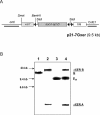Phase-locked mutants of Mycoplasma agalactiae: defining the molecular switch of high-frequency Vpma antigenic variation
- PMID: 18248580
- PMCID: PMC2268961
- DOI: 10.1111/j.1365-2958.2007.06103.x
Phase-locked mutants of Mycoplasma agalactiae: defining the molecular switch of high-frequency Vpma antigenic variation
Abstract
Mycoplasma agalactiae, an important pathogen of small ruminants, exhibits antigenic diversity by switching the expression of multiple surface lipoproteins called Vpmas (Variable proteins of M. agalactiae). Although phase variation has been shown to play important roles in many host-pathogen interactions, the biological significance and the mechanism of Vpma oscillations remain largely unclear. Here, we demonstrate that all six Vpma proteins are expressed in the type strain PG2 and all undergo phase variation at an unusually high frequency. Furthermore, targeted gene disruption of the xer1 gene encoding a putative site-specific recombinase adjacent to the vpma locus was accomplished via homologous recombination using a replicon-based vector. Inactivation of xer1 abolished further Vpma switching and the 'phase-locked' mutants (PLMs) continued to steadily express only a single Vpma product. Complementation of the wild-type xer1 gene in PLMs restored Vpma phase variation thereby proving that Xer1 is essential for vpma inversions. The study is not only instrumental in enhancing our ability to understand the role of Vpmas in M. agalactiae infections but also provides useful molecular approaches to study potential disease factors in other 'difficult-to-manipulate' mycoplasmas.
Figures






References
-
- Adams CD, Schnurr B, Skoko D, Marko JF, Reznikoff WS. Tn5 transposase loops DNA in the absence of Tn5 transposon end sequences. Mol Microbiol. 2006;62:1558–1568. - PubMed
-
- Altenbuchner J, Schmitt R. Transposon Tn1721: site-specific recombination generates deletions and inversions. Mol Gen Genet. 1983;190:300–308. - PubMed
-
- Askaa G, Erno H. ) Elevation of Mycoplasma agalactiae subsp. bovis to species rank: Mycoplasma bovis (Hale et al.) comb. nov. Int J Syst Bacteriol. 1976;26:323–325.
-
- d'Aubenton Carafa Y, Brody E, Thermes C. Prediction of rho-independent Escherichia coli transcription terminators. A statistical analysis of their RNA stem-loop structures. J Mol Biol. 1990;216:835–858. - PubMed
Publication types
MeSH terms
Substances
Grants and funding
LinkOut - more resources
Full Text Sources

